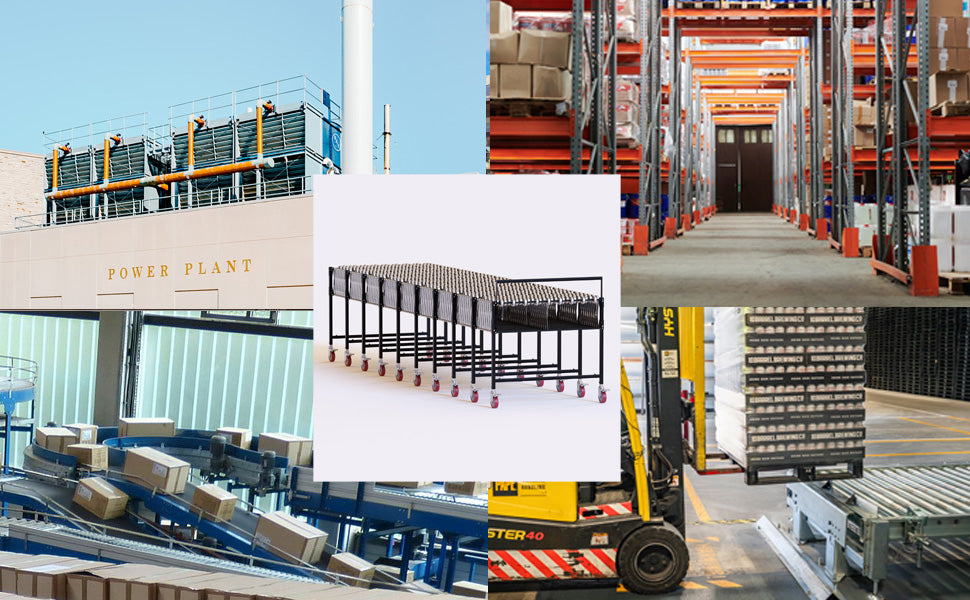What Is An Expanding Roller Conveyor System, And How Is It Different From Other Conveyor Belt Types?
Article published on Jan 26, 2022
Most people have a vague familiarity with what the term "conveyor belt" means, but for those who don't, a "conveyor" is simply a table-height device designed to smoothly move objects along from one end of the system to the other. This is most commonly used in manufacturing settings or assembly lines where a product must pass from one person to another. The easiest reference for most people is to imagine the conveyor belts which exist in airport TSA lines to smoothly transport luggage through the TSA process.
But what you may not know is that not all conveyor systems use belts. There are in fact different conveyor types, which we'll discuss in this post.
What are the different types of conveyor systems:
There are quite a few conveyor systems in existence. Some are powered by electricity or a motor and others are not powered at all. Some are stationary, and others are expandable or portable. The variations are endless and you can read about each of these granular differences in this extensive post about conveyor types. On a more basic level however, we'll explain the two most basic conveyor types: belt-driven and roller-bed-driven.
-
Belt-Driven Conveyor Systems, or "Conveyor Belts"
- Conveyor belts are conveyor systems which have a (usually rubber) belt which lays on top of the rolling system so that the products being moved sit on top of the belt, and the rolling system moves the belt along. Sometimes the belt is moved along with a system of pulleys, or sometimes there is a wheel or tube system moving the belt along. Other times there is a moving metal panel system underneath.
-
Roller Bed Conveyor Systems, or "Roller Conveyors"
- Roller bed or "roller conveyor" systems have the same tubes or wheels, but do not have a belt on top. This means the object being moved simply rolls along directly on top of the rolling tubes or wheels.
What are the practical differences between conveyor belts and roller bed conveyors?
Conveyor belts and roller bed conveyors achieve very much the same goal - smoothly moving an item from one person to the next, or from one area to another. However, there are use-cases which make one more reasonable than the other.
For instance if you are moving a product or item which has an irregular shape, or uneven weight distribution, you may need a flat, even surface to sit that object on so it doesn't get caught or snagged in the wheels. In these cases, a conveyor belt may be the better option for conveying items along from point A to B.
Unfortunately, using a conveyor belt means a fairly fixed length and pathway. The benefit of using an expandable roller bed conveyor system like this is that the system can easily be curved, stretched, or constricted to aid the passage of items across different distances or pathways. This may be useful for warehouses where items have different pathways to cross, rather than one single pathway to go through day in and day out.
To summarize, here are some of the primary benefits of an expandable roller bed conveyor system like those for sale at Crowd Control Warehouse:
- These expandable conveyor systems are collapsible for quick and easy storage. They can collapse down to a small, easy-to-store size.
- The conveyor system used in a roller bed conveyor can vary, but in this case, Crowd Control Warehouse offers a roller bed made from durable plastic skate wheels which provide exceptional spin, as well as flexibility. This means the system can be stretched or collapsed to different sizes.
- This conveyor type is suitable for even heavy loads with a load capacity of 250 lbs. per linear foot.
- Wheels allow this conveyor system to be maneuvered from place to place within a warehouse or factory.
- This conveyor system includes stops and clasps so the conveyor can be attached to another for a longer system, or can be stopped at the end to prevent items dropping off.



 Barricades
Barricades
 Belt Barriers
Belt Barriers
 Wall Mounted Belt Barriers
Wall Mounted Belt Barriers
 Classic Stanchions and Ropes
Classic Stanchions and Ropes
 Plastic Stanchion Posts and Chains
Plastic Stanchion Posts and Chains
 Signage
Signage
 Traffic Control
Traffic Control
 Chain Link Fencing
Chain Link Fencing

